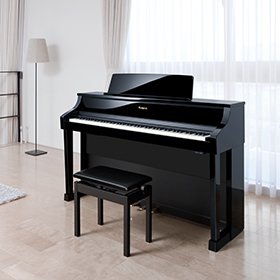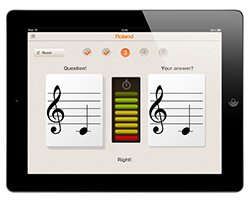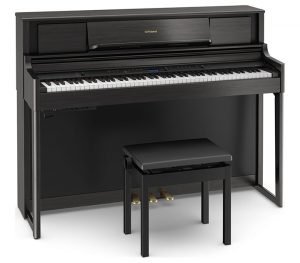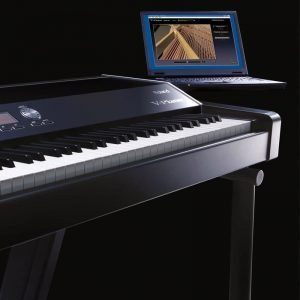By Robert Chamberlain, Team of Pianists (Reproduced with permission of the Victorian Music Teacher’s Association)
 Having trouble with the noise from your piano practice or your teaching studio? Perhaps your wife/husband/partner/family objects to your powerfully productive, extremely expressive 11pm – 2am practice sessions?
Having trouble with the noise from your piano practice or your teaching studio? Perhaps your wife/husband/partner/family objects to your powerfully productive, extremely expressive 11pm – 2am practice sessions?
Maybe your neighbours complain about your teaching studio? Do the screams of your students as you slam the piano fallboard down on their fingers detract from your neighbours’ quiet enjoyment of on-line gambling, trash TV and other highly intellectual pursuits?
Are your Year 11 and 12 VCE-studying student offspring demanding peace and quiet, even though you know they are actually updating their Facebook page, Skyping with their friends and trying to hack into Government websites!
Well, there are tradition solutions… and then there are digital solutions!
Divorce/separation is a tried and true favourite, of course— but it could be costly. Plus you can’t be sure who will end up with the better iPad, the urtext Beethoven Sonata editions or even the kids or the house.
Then there is soundproofing. You could employ an acoustic engineer, and spend tens of thousands of dollars to design and build a state-of-the-art acoustically-isolated music studio. Maybe model it on the music studio in the Japanese Association in Singapore, where the sound proofing is so amazing that musicians can practice Japanese drumming fortissimo in the studio above, without disturbing either the sushi chefs in the restaurant below, or the still living fish that are being carved, pianissimo, into sashimi just metres away!
Or you could send your school-age children to an exclusive boarding school. Preferably on the other side of the world, too far away to return home for weekend visits. Where their complaints about the way you earn dollars to pay for their lifestyle, oops, I mean education, cannot be heard.
These are all fine options but they are not cheap.
 A much better solution may be to warp into the alternative universe of digital pianos, as I did when I purchased, in 2012, a Roland HP-507 digital piano and some headphones.
A much better solution may be to warp into the alternative universe of digital pianos, as I did when I purchased, in 2012, a Roland HP-507 digital piano and some headphones.
At that time, the Roland HP-507, which has just been superseded by the even more advanced HP-508, was Roland’s top-of-the-line digital piano in the upright piano size. While it looks like a small upright piano, its sound, particularly in the bass register, is as rich, thick and as fat as the waistline of a no-brand surfing Santa in summer sans Santa suit, i.e. a very fat man in a skimpy swimming costume at the beach. Or, more tastefully, as rich in sound as the biggest concert piano you could find, perhaps a supercharged Schimmel K280 or a bulky, battlefield Bösendorfer Imperial (if these are still manufactured…).
But beware! If you use good quality headphones with the volume too high you run the risk of exploding your ears—there are just too many overtones and rich complexities in the sound! The sound without headphones is great too; indeed, one of the features of the HP-507 and the HP-508 is a sound projection system using six speakers to create a rich spatial sound all around the player.
Once you get used to the apparent contradiction between the small size of the instrument and its rich sound you can get down to business.
 The Piano Designer feature allows you to adjust, in multiple increments, multiple aspects of the sound. Parameters such as the degree of lid opening, soundboard behaviour, cabinet resonance, hammer noise, damper noise etc. are all under your control. The heaviness of the touch can be adjusted in 100 step increments; this seems to adjust the relative volume, but once underway it really feels like a differently weighted action.
The Piano Designer feature allows you to adjust, in multiple increments, multiple aspects of the sound. Parameters such as the degree of lid opening, soundboard behaviour, cabinet resonance, hammer noise, damper noise etc. are all under your control. The heaviness of the touch can be adjusted in 100 step increments; this seems to adjust the relative volume, but once underway it really feels like a differently weighted action.
A real treasure in this digital piano technology is the large range of sounds extra to modern piano sounds. I found that using various organ and harpsichord sounds on the instrument, whilst preparing works by Bach for performance on modern piano, was really useful – incredibly revealing of the music, not to mention the state of my preparation! Another great feature in this Roland series is the “Early Piano Sounds”, with four types of forte-piano and two types of harpsichord sounds. I guess such digital style-shifting may find disapproval with some professional purists, but it does delight this dabbling dilettante!
Indeed, this all makes me wonder about the geeks and boffins who work in Research and Product Development at Roland. Is not the real universe an analogue world, where strings and air columns vibrate from a hammer strike, a violin bow or the skilful blowing of some highly trained person with amazing lungs and an abdomen from a Pilates textbook. In the Roland universe it appears that the real world is digital, and my “normal” acoustic world is merely some kind of parallel reality, to be scavenged for inspiration and mined for raw digital material.
Would I be wrong to suspect some Roland engineers would rather digitally sample the “salt cured wallaby” or the “smoked eel with white chocolate and caviar” on the $250 degustation menu at Melbourne’s Vue du Monde restaurant rather than actually climb to the 55th floor of the Rialto building to experience these gastronomic delights in person?
 Certainly some of the advantages of this digital piano technology are immediately apparent. First, you can delete the listing for your piano tuner/technician from your iPhone. Pitch and even tuning temperaments are changed at the push of a button or two. A wide range of pitches means you can play at baroque pitches and with historical temperaments as well. Plus, unless you are hit by a climate-change induced power-outage courtesy of your loving electricity supplier, you will now no longer be at the mercy of climate-change induced tuning instability, from the heat-waves and cold snaps we now suffer. (Actually I hope the uptake of digital technology in the piano world does not reduce the numbers nor skills of our best tuners and techs who do such a superb job with our acoustic instruments.)
Certainly some of the advantages of this digital piano technology are immediately apparent. First, you can delete the listing for your piano tuner/technician from your iPhone. Pitch and even tuning temperaments are changed at the push of a button or two. A wide range of pitches means you can play at baroque pitches and with historical temperaments as well. Plus, unless you are hit by a climate-change induced power-outage courtesy of your loving electricity supplier, you will now no longer be at the mercy of climate-change induced tuning instability, from the heat-waves and cold snaps we now suffer. (Actually I hope the uptake of digital technology in the piano world does not reduce the numbers nor skills of our best tuners and techs who do such a superb job with our acoustic instruments.)
You can also throw your metronome out the window, or try to sell it (batteries not included) on eBay, because the metronome function is built in, or “on board” to use Rolandese.
Also the Roland’s small size allows you much more floor space than your average grand piano. Sadly that does mean more carpet to vacuum. On the other hand, you will now have space for your signed AFL footy-jumper collection display case, and/or your collection of Ming Dynasty vases or antique [Ed. redacted] (for the complaining neighbours).
 Plus there are interfaces, recording devices, widgets and gadgets to play back, record, transpose and do all sorts of things. The new model HP-508 even has a free iPad app called Piano Partner. You can “enhance your learning” with Flash Card, while Content Browser will allow you to explore its range of sounds and tones on your iOS device, while DigiScore Lite will display the instrument’s built-in songs as sheet music on your iPad. Indeed, I reckon finding out all the things the these digital instruments can do would keep even a 12-year-old digital native away from jail-breaking their iPhone for at least 25.47 minutes, while your average technologically-challenged digital-immigrant 50-year-old, will need days to explore all the possibilities, even while referring to the easy-to-follow user manual. Yet another good reason to put off doing any real practice!
Plus there are interfaces, recording devices, widgets and gadgets to play back, record, transpose and do all sorts of things. The new model HP-508 even has a free iPad app called Piano Partner. You can “enhance your learning” with Flash Card, while Content Browser will allow you to explore its range of sounds and tones on your iOS device, while DigiScore Lite will display the instrument’s built-in songs as sheet music on your iPad. Indeed, I reckon finding out all the things the these digital instruments can do would keep even a 12-year-old digital native away from jail-breaking their iPhone for at least 25.47 minutes, while your average technologically-challenged digital-immigrant 50-year-old, will need days to explore all the possibilities, even while referring to the easy-to-follow user manual. Yet another good reason to put off doing any real practice!
I really must explore more of how the HP-507 and its ilk can be used for teaching. There are of course two headphone jacks if you need them, and I expect that the recording and playback functions, the ability to create and playback files to and from your computer, and the range of sounds and touch will be useful and stimulating for students and teachers alike.
 I am impressed with the touch of this piano: Roland HP-507’s Progressive Hammer Action III seems to have copied the slimmer black keys of a Steinway or Schimmel concert piano rather than the slighter broader keys of the Yamaha concert grand and the 100-step touch variation option is effective. For the recently released HP-508, the “player-instrument interface” (a.k.a. the keyboard) has been upgraded, to the new PHA-4 Concert Keyboard. I would love to try it, but I must say that I have experienced no trouble at all swapping between the HP-507 and various large acoustic grand pianos. The pedals work well and the whole instrument looks very smart, even though I was warned off the classy looking polished black ebony finish, and opted instead for the very practical simulated rosewood case, which is less easy to scratch.
I am impressed with the touch of this piano: Roland HP-507’s Progressive Hammer Action III seems to have copied the slimmer black keys of a Steinway or Schimmel concert piano rather than the slighter broader keys of the Yamaha concert grand and the 100-step touch variation option is effective. For the recently released HP-508, the “player-instrument interface” (a.k.a. the keyboard) has been upgraded, to the new PHA-4 Concert Keyboard. I would love to try it, but I must say that I have experienced no trouble at all swapping between the HP-507 and various large acoustic grand pianos. The pedals work well and the whole instrument looks very smart, even though I was warned off the classy looking polished black ebony finish, and opted instead for the very practical simulated rosewood case, which is less easy to scratch.
There a few small niggles. Digital technology does not simulate well the use of sympathetic resonances, either by pedal or by holding down keys silently, so some contemporary works and some possible pedal effects, for example, in some sections of the Beethoven Sonatas won’t work. Also the music stand props seem a little flimsy and the music stand angle cannot be adjusted, so that page turns with old scores that are falling apart may be a little awkward.
 However, even though I have barely scratched the surface of all its capabilities, I am impressed with my HP-507 and with the potential of the whole digital experience. Indeed, just as we have cars with a hybrid drive-train, we can now retrofit a normal acoustic piano to bring it into the digital world. I have just seen the Genio Piano Silencer by Korean company Midmuro, a retrofit to acoustic grands or uprights. With mute rail, keysensor strip & pedal sensor, control and main unit, this turns an acoustic piano into a digital silent piano at the flick of a switch and the pull of lever, with headphone sound, MIDI Output and a wide range of pre-set sounds.
However, even though I have barely scratched the surface of all its capabilities, I am impressed with my HP-507 and with the potential of the whole digital experience. Indeed, just as we have cars with a hybrid drive-train, we can now retrofit a normal acoustic piano to bring it into the digital world. I have just seen the Genio Piano Silencer by Korean company Midmuro, a retrofit to acoustic grands or uprights. With mute rail, keysensor strip & pedal sensor, control and main unit, this turns an acoustic piano into a digital silent piano at the flick of a switch and the pull of lever, with headphone sound, MIDI Output and a wide range of pre-set sounds.
In fact, as time allows, I plan to research more widely this digital universe, as realised by Roland and others. While those things with two keyboards and lots of pedals – what are they called – oh yes – organs – probably require way too much co-ordination, did you know that Roland also make a digital harpsichord with a special sort of touch to simulate the plucking action? Hmm, now that’s really interesting…
Happy playing! (Hint: the power button is really easy to find!!)
Related Article
Learning Piano as an Adult
The Advantages Of Learning Piano As A Child
Related Products
- HP Series
- THE BEAUTY OF MUSIC
IN THE HEART
OF YOUR HOME (now replaced by HP-508) - Image: stefano cavoretto, yuriy kirsanov, felix pergande / 123RF








